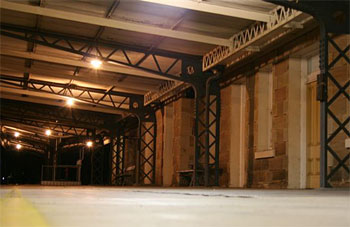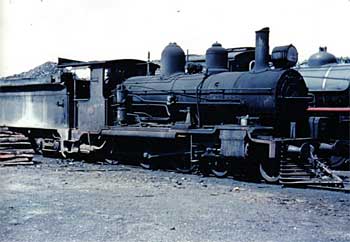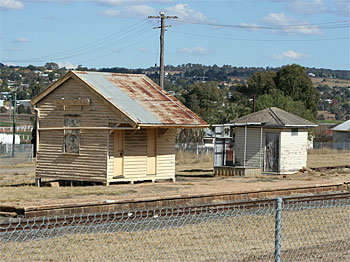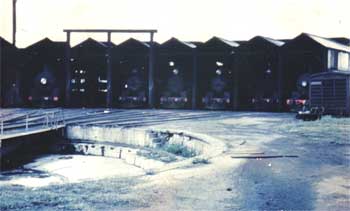Opened: 2 January 1888
Renamed: From ‘East Warwick’ to ‘Warwick’
Location: Southern Line
Status: Station and Goods Shed still in operation
Warwick had two railway stations.
The first opened in 1871 as ‘Warwick’ and was located on the northern side of the Condamine River. It’s name was changed to ‘Millhill’ in 1888.
In July 5, 1881, with the extension of the railway to Stanthorpe, a platform for passengers had been established at ‘East Warwick’ on the southern side of the river. By 1882, a shelter shed had been provided. Although not close to town, it was more convenient than old Warwick Station (Mill Hill) and plans for the Via Recta and St. George railway provided for East Warwick to be the main station.

The Platform and awning at the Warwick Station by night.
It was observed at the time that the shifting of the Warwick railway station to East Warwick, on the town side of the Balonne, would not be very expensive matter, and would be a great convenience to the good people of that place.
Work started in earnest at East Warwick in 1886. During March, a gang of men was to be set to work to lay down the rails for the new station yard and marking out the site for the buildings.
The plans of the new goods shed to be erected at East Warwick were lying at the Station Master’s office. “The building is to be a commodious stone and iron construction 200ft x 70ft, and will be erected on a spot on the western side of the line between Fitzroy and Grafton Streets.”
On JUNE 5, 1886 Tenders were invited for the erection of a new passenger station at East Warwick. The plans provide for a single story brick building 128 feet long by about 30 feet wide (not including verandah). The passenger platform would be 200 feet long. The accommodation provided includes a booking office 23 feet 6 inches by 9 feet 3 inches, station master’s office, waiting room, ladies room, telegraph office, porter’s room, lamp room, while the lessee of the refreshment room will have at his disposal a bar-room 21 feet 4 inches by 30 feet 4 inches and kitchen and servant’s room.
The new station, though not a very elaborate structure, was thought likely to meet the requirements of the town for some years to come.
Then on JUNE 26, 1886 Fresh tenders were called for the station, and the contract eventually went to R. Godsall for £5624 ($11,248). The building was built in local sandstone from Mt. Tabor Quarry, which was owned by Mr. D. Connelly. The stonemason being John McCullock.
The building, which was to be of pick-dressed stone, wit concrete floor and iron roof, would be erected a few feet south of Grafton-street. The contract price was about £5600, and the time fifteen months. The building would be 135 ft. long by 35 ft. wide; the platform would be 250ft. in length.
On OCTOBER 26, 1886 tenders were advertised for building an ash-pit, and foundations for a turntable at East Warwick and were awarded on December 21, 1886 to Mr. H. J. Godsall for £380 14s.
By DECEMBER 21, 1886 the walls of the new passenger station were beginning to show above ground. The original specification provided that Murphy’s Creek stone should be used in the front portion of the building, but it was decided to use Swan Creek stone instead.
It was reported on MARCH 5, 1887 that the stone and brickwork of the new passenger station was approaching completion, and if this building and the goods shed are not to lie ‘idle on completion’ it would be necessary to let the contracts for the engine and carriage shed, tank-stands, at an early date.
By late MAY 1887 the walls of the passenger station have been finished, and the carpenters are now engaged putting on the roof. The platform here is to be 250ft. long and 15ft. wide, filled in with muck top dressed with gravel. We quite agree with Mr. Alderman Sterne that this ought to be altered ; either asphalt or cement would be preferable in every way. The turntable and ashpit have been completed ; the former has a diameter of 40ft., sufficient to admit of engine and tender being turned at the same time. It is built of stone, and seems substantial enough to last until the crack of doom.
As yet there is no sign of a start being made with the other buildings – engine and carriage sheds and station master’s residence.
It was JANUARY 2, 1888 when the new Passenger Station and Goods Shed at East Warwick were occupied by the officers of the Railway Department for the first time. Hence forth traffic arrangements were conducted from this point.
Gas lighting was installed in April 1888. “The platform, office, were lighted with gas for the first time last night. The light was brilliant and steady, and in marked contrast to the “darkness visible” which was prevailed there up to the present. ” Mr. R. Williams, of Palmerin Street, contractor for the fittings, appears to have carried out his work in a highly satisfactory manner.
It wasn’t until APRIL 24, 1888 officials spent the afternoon marking out sites for the station-master’s residence, engine and carriage sheds, tank stand, in the newly completed East Warwick Yard. Plans of these works will be prepared at once, and the buildings will be erected without further delay. The Killarney line is to be deviated at the junction, so as to do away with the necessity for backing-in trains.
By 1900 a timber footbridge had been constructed off Grafton Street to plans of the Railways Section of the Works Department. This was planned to minimise the risk of people living on the eastern side of the railway complex, crossing the tracks. The Tighe brothers were awarded the contract, and the bridge which was lit with lamps and was built at a cost of £209/16/-.
WEDNESDAY, JANUARY 18, 1905 – (E&T) – RAILWAY TRAFFIC RECORDS – Business at the local railway station was very heavy during last week, particularly in the despatch of consignments of produce to over the border centres. In these wheat and maize bulked largely, and almost daily nearly 500 tons of produce have been despatched. Trains to Brisbane were also fully loaded with grain &c., from the Killarney and Thane branch lines. The cramped nature of the station and the want of siding accommodation is still keenly felt. On an average 24 trains a day were despatched from the Warwick station during the week.
In 1907 it was reported that one locomotive was stationed in Warwick. By 1911, it was reported that 15 locomotives was based in Warwick and up to fifty trains a day arriving and departed Warwick.
Around 1910-12 a new metal footbridge was built, comprises one 25 feet, three 58 feet and one 25 feet sections of steel lattice trusses with steel stairway stringers and guard fences both ends. It is supported on steel columns on concrete bases. The footbridge is rare (perhaps only) surviving example of a footbridge built in steel/wrought iron.
In 1912 Work commenced on the re-arrangement, enlargement and improvement of the staff quarters, machine shop and interlocking, and a new engine shed to hold seven locomotives and a 60 foot turntable, with two cabins controlling the yard. The sandstone that was used for turntable retaining walls and in other buildings in 1912 came from Yangan Quarry which was owned by the Brewer Family.
On MAY 24, 1913 the widening of the platform by 7 feet was completed and a new awning was erected and Warwick Locomotive sheds were completed on 7th September.
Attached to the depot were repair shops, employing about ten fitters. Lighter repairs, such as for carriages and wagons, and the putting on of new wheels are carried out. Forty loco engines are attached to the depot; also breakdown equipment and gang are kept in readiness for any emergency. In fact, the depot is a very busy section of the railway system.
On 29th November 1917 Warwick gained worldwide publicity when the Prime Minister Billy Hughes was giving a speech on the platform, when an egg was thrown at him, knocking off his hat. Hughes ordered the Warwick Constable “Arrest this man” but the policeman said “you have no jurisdiction”. This incident was associated with the forming of the Commonwealth Police Force. It is now know as ‘The Egg Throwing Incident”. This incident resulted in the Federal Police being formed.
In 1921 an elevated coal stage was erected on the south-eastern side of the Condamine River Bridge and was demolished in 1970. Evidence of where this coal stage was built can still be seen.
By 1926 close on 300 people were employed by the railways at Warwick. There were 130 in traffic (Station staff, guards, signalman, wagon maintenance), and 152 on the loco staff (drivers, firemen, mechanics, cleaners).
As many as 60 trains were dealt with in a 24 hour period, necessitating, among others, the services of four shunting shifts and three station masters. There were forty locomotives based in Warwick along with breakdown equipment to attend accidents and mishaps.
For the year ending 30th June, 1926, the number of passengers put through, exclusive of season ticket holders, was 40,461, the revenue derived from such, inclusive of season ticket holders, being £15,332. The revenue from parcels and miscellaneous traffic was £2736. During the same term 9789 tons of agricultural produce was dealt with (revenue £6718), also general merchandise 6416 tons (£10,114), wool 94 tons (£433), 382 tons of logs and swan timber: total outwards goods traffic, 16,922 tons (revenue £18,258); total revenue outwards £36,326. Inwards goods traffic dealt with totalled 16,922 tons (£18,258). The depot also deals with a considerable amount of live stock traffic
Trains were a popular attraction in the days gone by and Warwick was one place were the Commissioner reserved the right to charge sixpence for platform tickets on Sundays to reduce the crowd of onlookers.
Although no-one would have realised it, the decline of Warwick started 1953 when the first diesel arrived.
By 1959 with the Via Recta unfulfilled, goods and especially passenger traffic to Warwick was very susceptible to competition and after the post World War 2 period Warwick had declined in importance. Economies were affected in 1959 when Cabin A was disconnected and a 2-lever frame provided on the platform to control the up home and outer home signals in conjunction with Cabin B, much interlocking being disconnected in the process.
The station building was guttered by fire on 29th September, 1963. Bond-wood huts were placed on the platform under the awning until the building was restored internally (but without the refreshment room) and re-opened in late 1964-early 1965.
With dieselisation in 1967, Warwick was practically eliminated as a locomotive depot, the working being Toowoomba to Wallangarra or Inglewood, but shunting and Amiens trains were locally worked – it still had a C-17 class engine (No.971) late in 1968.
Full closure was not implemented due to political and union pressure until early 1970’s. 100’s of railway employees lost their jobs or were transferred elsewhere. This hit businesses in Warwick hard as over a million dollars in wages that was spent in the district every fortnight was lost.
In late 1969 or early 1970 the locomotive depot along with the associated buildings were demolished and so was the coal stage and water tanks. Inspections pits filled in and only one of the locomotive roads along with the turntable remained.
Although the Station Building and Goods Sheds survived, a significant amount of Warwick Yard has been lost. Gone are the signal cabins, signals, and many of the sidings. What is left here is only a shadow of yesteryear.
However, the SDSR has restored 4 of the 7 bays of the locomotive roundhouse, and C17 971 has returned to the shed for restoration. In an era where steam was king, and Warwick had a hustling Railway, only peace and quiet remain, except for the return of steam.





